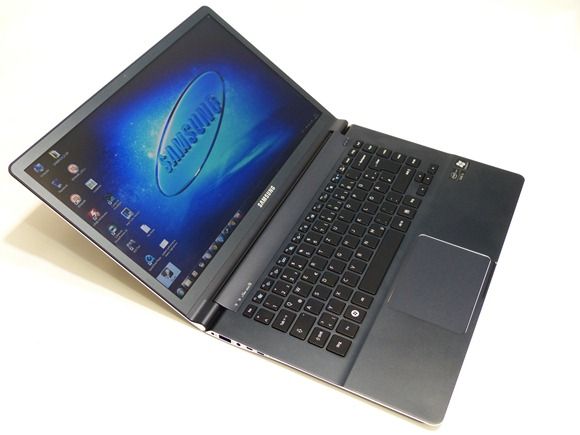
The 15” Samsung Series 9 2012 with Ivy Bridge has been a pleasure to test. It’s a stylish Ultrabook with potentially very long battery life and a great 3D performance boost over 1st-generation Ultrabooks. The screen is good and bright and the keyboard a pleasure to use. But all is not perfect. A surprising lack of CPU Turbo under battery load, a strange touchpad action and too many ‘micro’ ports takes some of the shine from the Series 9 but despite that, it sits in a unique position in the market. There are cheaper Ultrabooks in the 15” bracket but you won’t find a 1600×900 screen for this price or weight.
The First 5 Minutes
Check out our initial unboxing video here where we give you an overview of the Samsung Series 9. You’ll see that the packaging is top quality and that we’re very happy with the design and finish. It’s going to be rare that an owner is disappointed with the Series 9 within the first 5 minutes.
Live Review
You can find the Samsung Series 9 in our live review videos. In the article you’ll also find our first impressions and some notes on issues.
Specifications
The model reviewed here is a preview release of the Samsung 900X4C with a Core i5-3317 Ivy Bridge CPU at 1.7Ghz, 8GB of RAM and 128GB SSD. Base model specifications include ports and features along with links to Samsung Series 9 news are always available in our database.
Size and Weight
At 1660gm, 3.6lbs (measured here) the 15” Samsung Series 9 is impressively light. The thin-bezel screen gives the feeling that it’s a smaller device than it really is. The metal casing has very solid feel.
Ports
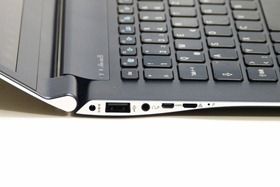
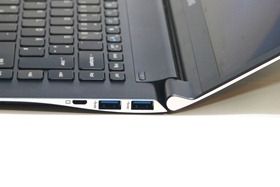
Samsung have provided a good selection of ports despite the thin casing but in order to squeeze everything in they’ve had to use three micro-sized ports, two proprietary, that will require adaptors. Micro-HDMI cables are cheap and easy to find but the VGA adaptor is something that many will have to take the time to order. Given that Samsung have provided the micro Ethernet port adaptor with the Series 9 and that they provide a VGA adaptor with the budget-level Series 5, it seems like penny-pinching at this price-point and it’s unexpected. Samsung have fortunately included a full-size SD card slot.
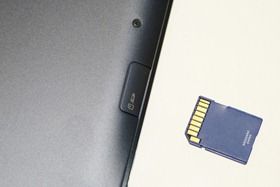
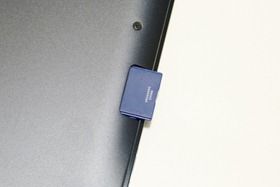
Two USB3.0 ports and a USB2.0 port are included along with a combination headset port.
Screen
The screen on the Series 9 is one of the high points. It’s a 1600×900 resolution unit with matt finish, good side-to-side viewing angles, good colour and contrast and a very high brightness. A full HD IPS-style unit would have been better and given that ASUS and Apple are offering these on their high-end ultralights, maybe Samsung is beaten in the specs department here. However, 1600×900 works well for default font sizes in Windows and provides a very comfortable experience.
We took the Series 9 outside in bright daylight and tested it side-by-side with another matt screen Ultrabook.
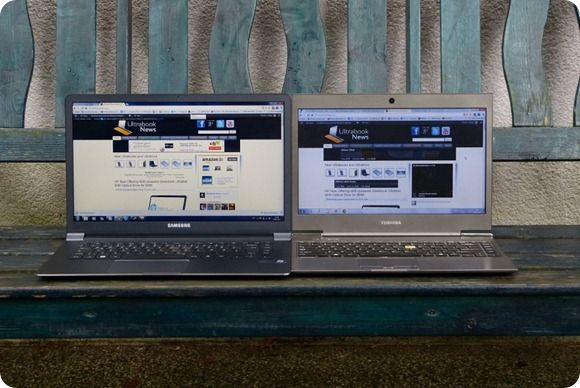
It’s often difficult to determine brightness differences between screens but in this case the winner is clear. The Samsung Series 9 15” offers usable screen brightness in bright daylight conditions. The only disadvantage here is that the screen is big and to provide that much backlight takes a huge amount of energy. See the battery life testing section below for more.
Ivy Bridge supports three concurrent screens but on the Samsung Series 5 we were only able to activate any two of the HDMI, VGA and laptop screens at one time.
Keyboard / Trackpad
It’s been a long long time since this reviewer has used a keyboard on a 15” device. Many years of 10-13.3” usage means the keyboard almost felt too big. After a short while it felt comfortable though and the responsiveness felt good over the whole keyboard. Key travel is short but there’s a good ‘give’ to the key which provides enough feedback to the touch typist. The keyboard backlight is self-regulating although it seems weak compared to other backlit keyboards we’ve tried. The backlight turns off automatically under bright conditions.
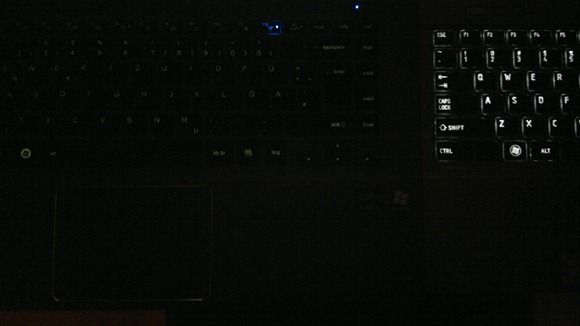
Just visible; the backlight on the Samsung Series 9 on the left and part of the Toshiba Z830 on the right.
In real life the eyes are able to gain an advantage through the use of the backlight but given that there are three level settings, the brightest setting should be at least twice as bright as this to cover more low-light scenarios.
The touchpad is by Elantech and comes with an array of multitouch settings. Unfortunately it’s pre-configured with pointer momentum when the finger is left on the touchpad. After about 4 days we were getting used to the effect but it doesn’t seem to have any obvious advantage. Samsung, please ask Elantech to provide an option to turn this off.
Further problems on the touchpad were had with mouse button detection. While tap-to-click works reliably, the integrated mouse buttons don’t. Time and time again we were waiting for actions only to find out that the click had not registered. This problem seemed to get worse under load which points to a software problem that we hope Samsung can get fixed. We’ve passed details of our issue to Samsung and are waiting for feedback.
General Performance
The Samsung Series 9 900X4C is the first Ivy Bridge device we’ve had to test and it performed just as we expected. There are no significant battery life advantages to have with the CPU but the graphics are hugely improved. Gaming results ranged from 70% to 100% better than we’ve seen on some Sandy Bridge platforms and there’s an advantage for the media enthusiast too. More performance testing results below.
Boot, Standby
Boot from cold includes a 3-second BIOS period followed by system boot for a 21-second total. (Fresh Windows 7 build) Return from standby is very quick at under 2 seconds. Return from hibernation is under 10 seconds. We haven’t measured standby battery life drain.
Disk – Speed, Size
The SSD on this review device is surprisingly a Sandisk U100 and not one of Samsung’s own models. It’s not particularly fast either although the results blow away anything you’ll see on a laptop hard disk.
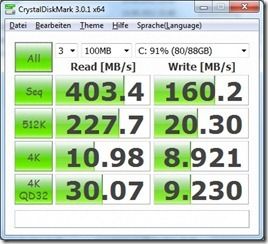
On the top the Samsung Series 9 2012. In the middle the Samsung Series 9 2011 and on the bottom, the Toshiba Z830. At first glance it looks like the disk on the newer Series 9 is faster but the important figures – the write speeds at 512K and 4K block sizes are all down. The 512K block size write results are particularly disappointing and we can feel the difference. We even sensed some unexpected wait time on Windows 7 which could well be attributable to the poor small-block write speeds. Overall we have to say that dispite a high maximum read speed, we’d rather see the SSD from the older Series 9 back in action.
Our test device came with about 90GB free. There’s a recovery partition on the disk and the 8GB RAM makes for some large pagefile and hibernation files that take up large chunks of the disk. We completely filled the SSD after our testing (including 6 large game downloads) so watch-out casual gamers!
Audio
Speaker quality is good enough for a laptop. It’s not quite what we hear and enjoy on the ASUS Zenbooks but better than say the Toshiba Z830 which, in turn, is also acceptable. Analogue audio output through the headset port was without issues although for the best audio experience you’ll want to take the digital output from the HDMI 1.4 port.
Video
Background on Ultrabook video performance:
The video playback capabilities of PCs have three limiting factors. CPU, video decoding hardware and software codecs. Windows 7 provides a good set of software codecs out of the box and supports most hardware video decoders. MPEG2, MPGEG4 part 2 (like Xvid, Divx) and MPEG 4 part 10 (like H.264) along with WMV of course. You’ll need to download and install codecs for other types of file.
The Samsung Series 9 2012 with Ivy Bridge uses the new HD 4000 integrated graphics unit with improved media capabilities. (Overview here.)
The HD 4000 GPU supports full HD (1080p) decoding in hardware and we tested it up to 30Mbps which is as high as you’ll get on most consumer video cameras. In theory the chip can decode twice that much and can even handle 4K video decoding and display. Unfortunately we weren’t able to test that that. CPU usage levels are impressively low on decoding HD video content and the fan didn’t come on while we were testing video playback.
Color levels are punchy and we were truly impressed with the 1080p trailer for Timescapes – a fantastic experience.
The Wi-Fi card, a Centrino N 6230 module, supports Intel Wireless Display (Wi-Di) so you can send 1080p video (up to 60fps) to a screen without a cable. Wi-Di is not a lossless transport and targeted at video, not wireless desktop usage. [Samsung are releasing a Wi-Di-capable desktop monitor though so maybe there’s scope for desktop usage in the new HD4000/Ivy Bridge variant of Wi-Di.] Wireless CD-quality audio is also supported over Wi-Di. A Wi-Di / HDMI receiver costs from around $50. All Ultrabooks include the Intel Quick Sync Video hardware that, through use of an Intel SDK, can provide accelerated decoding and encoding capabilities for common video file formats. The HD4000 implementation is theoretically faster than the HD3000 implementation.
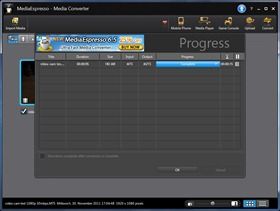 Using Cyberlink MediaEspresso, which supports the Intel Quick Sync Video subsystem, we matched the best results we’ve seen on 1st-Generation Ultrabooks. Converting a 50 second 1080p to 480p 2mbps took just 15 seconds under mains power. Under battery power the Turbo Boost doesn’t appear to be utilized and the result was 20 seconds at best.
Using Cyberlink MediaEspresso, which supports the Intel Quick Sync Video subsystem, we matched the best results we’ve seen on 1st-Generation Ultrabooks. Converting a 50 second 1080p to 480p 2mbps took just 15 seconds under mains power. Under battery power the Turbo Boost doesn’t appear to be utilized and the result was 20 seconds at best.
There may be further optimizations needed to MediaEspresso to take advantage of new features in the latest Intel Media SDK and we’ve asked Cyberlink to comment on upgrades to their software.
Gaming
Stay with us at Ultrabooknews because we plan to step up our gaming coverage. Why? Because the HD 4000 GPU is a huge improvement from the HD 3000. In an nutshell, we’re seeing 70-100% frame-rate improvements which is significant because it brings many games up to the magic 30fps ‘playable’ level. In Just Cause 2 we saw a huge jump in the frame rates on the benchmark test. From an average of about 9 fps to about 18 FPS with a 1366×768 screen resolution. Take a look at the video below for some gaming action recorded by video camera from the Samsung Series 9.
The fan noise is relatively quiet under gaming load although as with all Ultrabooks, battery drain goes way up. Don’t expect much more than 2.5hrs for intensive games.
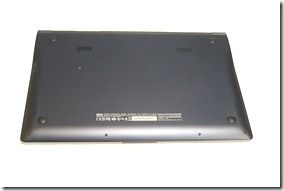
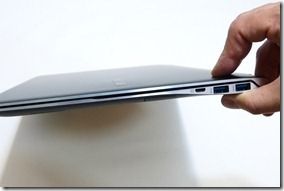
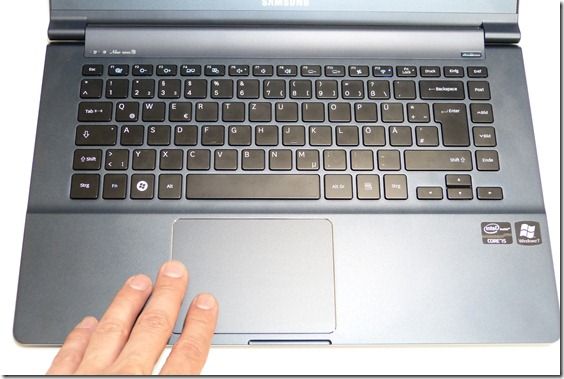
Support Ultrabooknews and our detailed reviews.
You’ll find a Facebook ‘Like’, Twitter and Google +1 buttons at the top of this post. Please take the time to promote us if you feel this review was useful. It will help us with the next Ultrabook review. Thanks!
Networking
The Samsung 900X4C integrates an Intel Centrino N 6235 Wifi and Bluetooth module. The module includes My-Wifi (Wifi direct) support along with Wireless Display support. Antenna reception and throughput was a little dissapointing. In a side-by-side test with the Toshiba Z830 which has the same Wi-Fi module, the Toshiba sustained far higher throughput. Throughput was, however, higher than we’ve seen on previous Series 9 laptops and in the ‘average’ range for Ultrabooks we’ve tested.
We failed to send an image to the Series 9 over Bluetooth from a Nokia phone and Samsung tablet and trying to connect with a similar Ultrabook also failed. We’ve seen this on other Intel Centrino-based devices and it’s just another example of the hit-and-miss affair that is Bluetooth.
The Gigabit Ethernet adaptor worked as expected.
Continued on next page…
Pages: 1 2

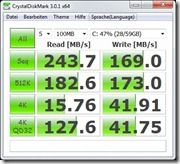
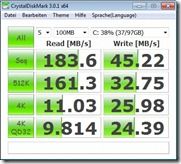










Thank you. Perfect Test.
With an give away it will be great :) But I will buy it in the 14 inch version
i have this book. about the performance of this ow sum too good too fast. about its specification or price details please vizit http://www.mobileshunt.com/samsung-s9-15-premium-ultrabook/
One more time a very good test.
I’ve it since it was released two weeks ago. I’m using it for my work as a freelance software developer. And I’ve to say, I it’s perfect for me.
And I’ve no issues with the Elan touch pad except of the settling in period.
Is it possible to change the SSD or is it welded in?
I asked a retailer the same question (although about the 13.3″, but I assume it’s the same) and he said it was possible to remove/change the SSD. It’s currently a U100 Sandisk, like chippy said, with a mSATA connector.
http://www.sandisk.com/Assets/Umbraco/AboutSandisk/MediaKit/BusinessOEM/OEM/large/U100_mSATA_Angle.jpg
I asked a retailer and Samsung Germany, too. They both said that it is possible. If it is done by their service partners you won`t loose your warranty.
Unfortunately, the lack of Turbo under battery must be a conscious decision.
Arggh, looks like PC manufacturers didn’t reduce the cooling solution gap compared to Apple. The new Macbook Air takes full advantage of Turbo in the 11-inch chassis, while maintaining the best gaming performance for Intel graphics.
Thermal limits are tighter under mains power due to charging heat. Why would you turn off Turbo under battery apart from wanting to save battery life? (in which case the user could choose a battery saving profile)
It probably does have some Turbo, just that its very short duration. So it ends up being a pure responsiveness feature, rather than actual performance improvement. It’s same with their 1st generation Series 9. Similar thing also happens with Slate 7, except rather than base it runs at LFM(like a pseudo cTDPdown).
The big issue I see with Samsung’s implementation is that people aren’t going to be doing compute intensive tasks on battery. They’ll be connecting it to AC, so why gimp its performance? If they do it, it’ll be done for a short time, meaning faster times with Turbo will offset increased power usage. And on light usage, it does not matter.
Great review Chippy thank you. Little bit dissapointed from the 15″ screen(no IPS like the 13″) and the really low backlit keyboard, but otherwise it’s perfect :) Already ordered mine – 3-5 weeks waiting period ((
Great review…but I was just wondering if you could comment on the folllowing:
CPU usage when doing large file copies with the LAN adapter
Is it possible to upgrade memory and/or SSD
Is there a hidden WWAN slot at all?
Is the battery removable?
Thanks
Awesome review, i hope to see more like this :)
Awesome review!
Quite dissapointed by the SSD – both the fact that it’s a Sandisk and that 256Gb isn’t optional. Also unfortunate that the SD card sticks out as much as it does, otherwise it could be used for additional storage. Adding one of those super small USB memory sticks isn’t really an option either considering we only have 2 slots in the 13.3″ version. If you go for the 15″ version I guess it might be more appealing. There’s cheap 32Gb versions of those small memory sticks at the moment, and I suspect that 64Gb isn’t too far away.
Very interesting to hear that the silent mode locks the processor to 800Mhz. Makes the whole thing a lot less interesting to me.
I still can’t decide between the 13-inch version of this, or the UX31A. :)
appearently media markt germany the lists the zenbook prime in germany .. i am keen to make my buy i hope chippy can review compare it to the samsung 9 soon.
I’m “lucky” in that I’m abroad for another 4 weeks before I get home and can buy a new laptop. If it wasn’t for that I probably would have already gotten either of these. Now I can await the Zenbook review and make more of an informed buy. :)
The SSD size still irks me, but I figure I’ll get by with a NAS or USB/SD memory until mSATA prices drop and I can get a 256Gb.
I’m in contact wuth ASUS!
@ Chippy!
I wanted to tip you about something. This online webstore has the ASUS Zenbook Prime for the Netherlands.
http://www.laptopshop.nl/product/190154/asus-zenbook-ux31a-r4003v.html
^WITH Windows 8 Pro upgrade.
Also, the Lenovo ultrabooks have ben showing up at MediaMarkt Netherlands (the U310’s)
that´s exciting chippy, i hope you get a zenbook prime for testing soon:)
When you took the piture of the keyboard backtight, had you increased the the backlight to maximum? Fn key plus F5 or FnF10. I’ve placed one in the field and the unit comes with the backlight turned all the way down (I asume that they want the battery to last longer in testing).
Yes. I had the brightness turned up to full. I also used the Samsung Easy Manager to turn the brightness up to full. It’s possible we have a faulty unit of course.
Maybe they figured that it would be better to have three low settings to better fit most people? I’m guessing the stronger light just gets annoying. At least I’d figure I’d want a pretty low light setting, but it does look very low for being max in the picture.
What doesn’t look at all as muted is the brightness on the Power button and WiFi On/Off button. Looks like something that could be pretty irritating in a low light
Good point MP.
We’re about to buy several of these for the company and I’m checking up on the accessories before we do. As they are for work and we go out seeing lots of companies we will need the VGA dongle in case we have to connect a customers projector.
I can’t seem to find anywhere in Australia selling these add on dongles and it seems they are hard to find overseas as well. This seems like a major shortcoming, am I missing something? Maybe I need to go to a retail store?
The dongles aren’t even listed on the Samsung Australia website.
Today i bought a 900X3C and asked for the VGA-dongle. Samsung is`nt able deliver it at the moment – just like you researched. Here in Germany they said that the dongle will probably be available next week.
Btw., the LAN-dongle is included.
The 900X3C also uses the Sandisk U100. I wanted 256GB of storage but Samsung can`t deliver bigger SSD´s at the moment, too.
We have to wait.
Thanks for the useful information Thinyo.
to whom it may concern, i made the plunge today:-) ordering the 13 inch samsung series 9 with i5 and 128 ssd, i simply couldnt wait anymore:) after a long back and forth between the samsung 9 and the zenbook prime i went for the samsung so let´s see:)
Congratulations Robert. You’ll be blown away by the screen on it for a start! We’d love to get an owners report from you if you have time to write anything. Happy to publish and link back to your chosen website.
thank you Steve!!:-) I am really excited about getting :) i am not really tech competent or good reviewer by any strech … but i am sure i will bubble over and write once i start experiencing my new ultrabook:)
I am planning to try to connect my samsung series 9 13inch to my hdtv screen (also samsung) can anyone help me with a suggestion .. would it be better to use a hdmi adapter and cable to the tv or use intels WiDi and doing it via something like the netgear push 2 tv ? I´d really appreciate any input as to what to get:-)
For quick setup, true 1:1 digital picture quality, take the HDMI. every time unless wireless solves a problem.
Ivy Bridge does however support 60fps 1080p Wi-Di now and Samsung are releasing a desktop monitor with Wi-Di support which hints that Wi-Di is getting better.
However, it remains a lossy transmission mechanism.
As i am awaiting my samsung series 9, i think of ways to encrease my storage, i am playing with the thought of buying a 128 gb usb stick and a 128 gb sd card .. this together with the 128 ssd drive of the samsung would boost my device up to 384 gb ssd :-) my question is does anyone know if the samsung should be able to swallow 128 usb sticks n sd cards?
Thank you Steve that was actually very helpful .. i think i will go for cable n or dongle for now and see what i can do with it .. if need be i can still consider WiDi in the future .. as it looks like i wont be even needing samsungs vga- to macro HDMI dongle (if thats the right one, i get confused a bit with their dongles .. i could go for a much cheaper option using this cable with a micro HDMI on the one and and a “normal size” at the other ? it´s just 6,90 euros is there some reason this shouldnt work with the samsung?
http://www.amazon.de/mumbi-Micro-HDMI-Kabel-1080p/dp/B004QIHAVE/ref=sr_1_5?ie=UTF8&qid=1341184119&sr=8-5
Hmm i’m about to order a new laptop but i don’t know if i should go for the ux32vd and upgrade it with samsungs 830 ssd or pick the 13,3″ 9 series..
does the 13,3 9 series got a better viewing angle or is it the same as the 15″? :)
Hello Simon:)the 15 inch has a great screen but the 13 inch is fantastic:)its samsungs equivalent of ips awesome angles vibrant colour no bleed .. i just bought the 13 inch model and been enjoying it since saturday:-)
Hello Simon:)the 15 inch has a great screen but the 13 inch is fantastic:)its samsungs equivalent of ips awesome angles vibrant colour no bleed .. i just bought the 13 inch model and been enjoying it since saturday:-)
Sweet i might go for the 13 inch. no bleed awesome screen, replaceable msate, sexy design and super light weight.
the only thing i still don’t like about the 9 series is the cpu turbo turns off when it’s running on battery :(
i really hope they are going to fix it or there is a way to turn it on in bios :)
I got my 15″ S9. It was bought in America and I’m in Europe. Where can I buy power connector for Europe, because it’s so big with transducer?
Thank you
Does anyone know if there is a portable battery that would work in the power port? I am going on a trip to Europe and I am hoping to make it the full trip, knowing I will need supplemental power. Any suggestions?
Thanks
I just got mt 15″ Series 9 with Core i7, 250GB SSD, 8GB Ram…
Get the 250GB one…and use a skydrive, dropbox, and a 64GB stick,
I can’t use ready boost with a USB Stick to increase RAM as it says I can’t benefit from it.
Congratulation for your purchase :-) the samsung series 9 is a fantastic machine:-) i got mine ( a 13 inch) a few months back now and i enjoy it every day. I simply could not wait for the 256 gb ssd version and went for the 128 which i run with a 64 gb sd card always in place. You are very right in retrospect i should have gone for 256 gb i recommend that too, skydrive is an option i did not think about nice one 25gb free online ! I got a 1 TB 2.5 inch small external hard drive which works awesome ( from WD) to boost the already good for ultrabook sound I got myself the bose soundlink blue tooth speaker which delivers great sound :-) if i am lucky i get 1 year of spotify for Christmas yay ! Enjoy your new smooth Samsung Series 9 :-)